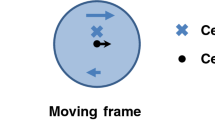Abstract
We examine the possible role played by field angular momentum in two systems of vastly different sizes: (i) the nucleon and (ii) highly magnetic white dwarf stars. For the nucleon we study the restrictions on the nucleon's structure that arise from the requirement that the total field angular (spin, orbital and field angular momentum) should satisfy the standard angular momentum commutation relationship. For the magnetic white dwarfs we argue that the magnetic field may alter the statistics of some fraction of the white dwarf's electrons from fermionic to bosonic. This would effect the stars structure, giving it a smaller than expected radius, and a lower than expected temperature. In some extreme cases one could imagine that this effect could lead to the collapse of the white dwarf into a neutron star despite being below the Chandreshekar limit.
Similar content being viewed by others
References
M. N. Saha, “On the origin of mass in neutrons and proton's, ” Ind. J. Phys. 10, 145-151 (1936). M. N. Saha, “Note on Dirac's theory of magnetic poles, ” Phys. Rev. 75, 1968 (1949). H. A. Wilson, “Note on Dirac's theory of magnetic poles, ” Phys. Rev. 75, 309 (1949).
J. Ashman et al., “A measurement of the spin asymmetry and determination of the structure function G(1) in deep inelastic muon-proton scattering, ” Phys. Lett. B 206, 364-370 1988); J. Ashman et al. “An investigation of the spin structure of the proton in deep inelastic scattering of polarized muons on polarized protons, ” Nuclear Phys. B d328, 1-35 (1989).
X. Ji, “Gauge invariant decomposition of nucleon spin and its spin-off, ” Phys. Rev. Lett. 78, 610-613 (1997); X. Ji“Deeply virtual compton scattering, ” Phys. Rev. D 55, 7114-7125 (1997).
P. Hoodbhoy, X. Ji, and Wei Lu, “Implications of color gauge symmetry for nucleon spin structure, ” Phys. Rev. D 59, 074010(1999).
D. Singleton and V. Dzhunushaliev, “Orbital and field angular momentum in the nucleon, ” Found. Phys. 30, 1093-1105 (2000).
D. Singleton, “Glueball spin, ” Modern Phys. Lett. A 16, 41-51 (2001).
F. Mandl and G. Shaw, Quantum Field Theory, rev. edn. (Wiley, New York, 1984), p. 86.
D. Singleton, “Electromagnetic angular momentum and quantum mechanics, ” Amer. J. Phys. 66, 697-701 (1998).
D. Singleton, “Electromagnetic contribution to the nucleon spin, ” Phys. Lett. B 427, 155-160 (1998).
A. DeRujula, H. Georgi, and S. L. Glashow, “Hadron masses in a gauge theory, ” Phys. Rev. D 12, 147-162, (1975).
M. Kirchbach, M. Moshinsky, and Yu. F. Smirnov, “Baryons in O(4) and vibron model, ” Phys. Rev. D 64, 114005(2001).
D. Ahluwalia and M. Kirchbach, “(1/2, 1/2) representation space: An ab initio construct, ” Modern Phys. Lett. A 16, 1377(2001).
S. Chandrasekhar, “The density of white dwarf stars, ” Phil. Mag. 11, 592-596 (1931); S. Chandrasekhar“The maximum mass of ideal white dwarfs, ” Ap. J. 74, 81-82 (1932).
L. D. Landau, “On the theory of stars, ” Phys. Z. Sowjetunion 1, 285-291 (1932).
S. Coleman, “The quantum sine-Gordon equations of the massive Thirring model, ” Phys. Rev. D 11, 2088-2097 (1975).
S. Mandelstam, “Soliton operators for the quantized sine-gordon equation, ” Phys. Rev. D 11, 3026-3030 (1975).
A. Luther, “Bosonized fermions in three dimensions, ” Phys. Rept 49, 261-266 (1979).
R. Jackiw and C. Rebbi, “Spin from isospin in a gauge theory, ” Phys. Rev. Lett. 36, 1116-1119 (1976).
P. Hasenfrantz and G. 't Hooft, “Fermion–Boson puzzle in a gauge theory, ” Phys. Rev. Lett. 36, 1119-1122 (1976).
R. E. Prange and S. M. Girvin, The Quantum Hall Effect, 2nd ed. (Springer, New York, 1990).
J. K. Jain, “Composite-fermion approach for the fractional quantum Hall effect, ” Phys. Rev. Lett. 63, 199-202 (1989).
D. Singleton and J. Dryzek, “Electromagnetic field angular momentum in condensed matter systems, ” Phys. Rev. B 62, 13070-13075 (2000).
S. M. Girvin and A. H. MacDonald, “Off-diagonal long-range order, oblique confinement, and the fractional quantum Hall effect, ” Phys. Rev. Lett. 58, 1252-1255 (1988).
D. H. Lee and C. L. Kane, “Boson-vortex-Skyrmion duality, spin-singlet fractional quantum Hall effect, and spin-1/2 anyon superconductivity, ” Phys. Rev. Lett. 64, 1313-1317 (1990).
A. Wolszczan and D. A. Frail, “A planetary system around the millisecond pulsar PSR 1257+12, ” Nature 355, 145-147 (1992).
F. Wilczek, “Magnetic, flux, angular momentum, and statistics, ” Phys. Rev. Lett. 48, 1144-1146 (1982).
A. Goldhaber, “Connection of spin and statistics for charge-monopole composites, ” Phys. Rev. Lett. 36, 1122-1125 (1976).
J. D. Jackson, Classical Electrodynamics, 2nd edn. (Wiley, New York, 1975), p. 251.
J. Dryzek, A. Kato, G. Muñoz, and D. Singleton, “Electrons as quasi-bosons in magnetic white dwarfs, ” Internat. J. Modern Phys. D 11, 417-425 (2002).
H. J. Lipkin, W. I. Weisberger, and M. Peskin, “Magnetic charge quantization and angular momentum, ” Ann. Phys. 53, 203-214 (1969).
I. S. Suh and G. J. Mathews, “Mass-radius relation for white dwarfs, ” Ap. J. 530, 949-954 (2000).
N. Nag and S. Chakrabarty, “ Can a very low-luminosity and cold white dwarf be a self-gravitating bose condensed system?, ” astro-ph/0008477.
J. A. Pons et al., “Nearby isolated neutron star RX J185635-3754, ” Ap. J. 564, 981-1006 (2002); J. J. Drake et al., “Is RX J1856.5–3754 a quark star?, ” Ap. J. 572, 996-1001 (2002).
Author information
Authors and Affiliations
Rights and permissions
About this article
Cite this article
Kato, A., Muñoz, G., Singleton, D. et al. Field Angular Momentum. Foundations of Physics 33, 769–780 (2003). https://doi.org/10.1023/A:1025649007365
Issue Date:
DOI: https://doi.org/10.1023/A:1025649007365




